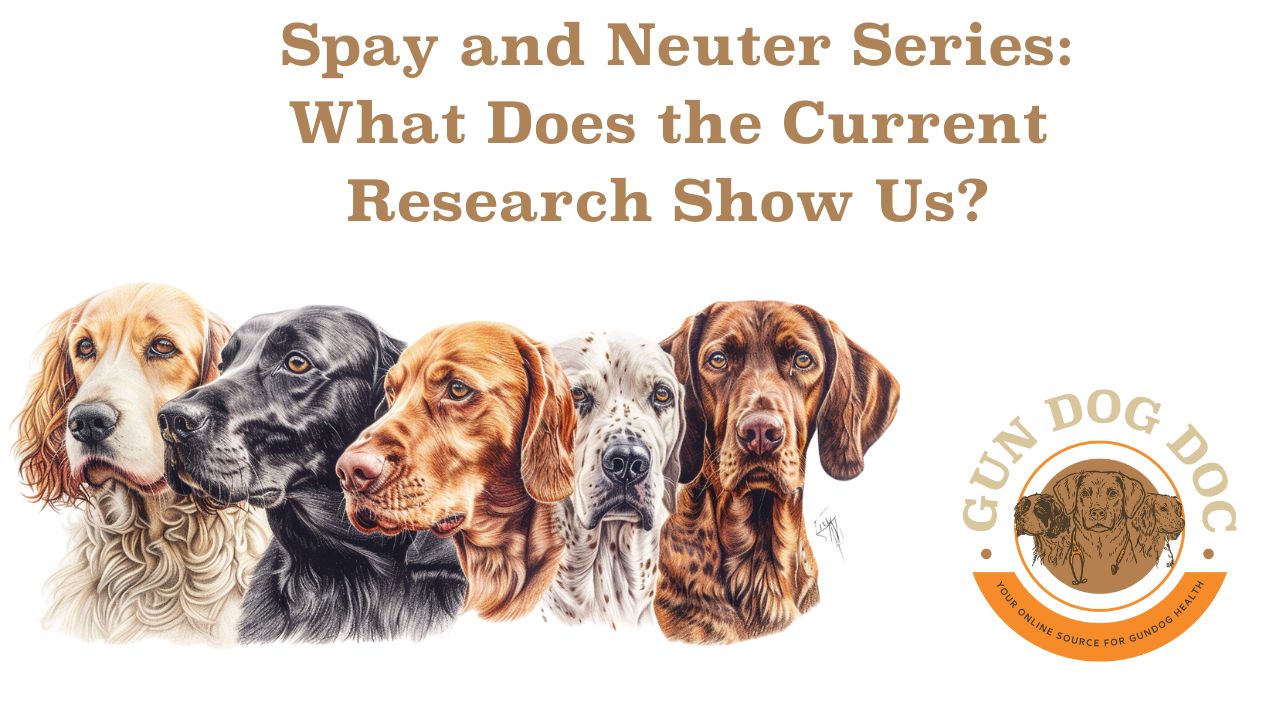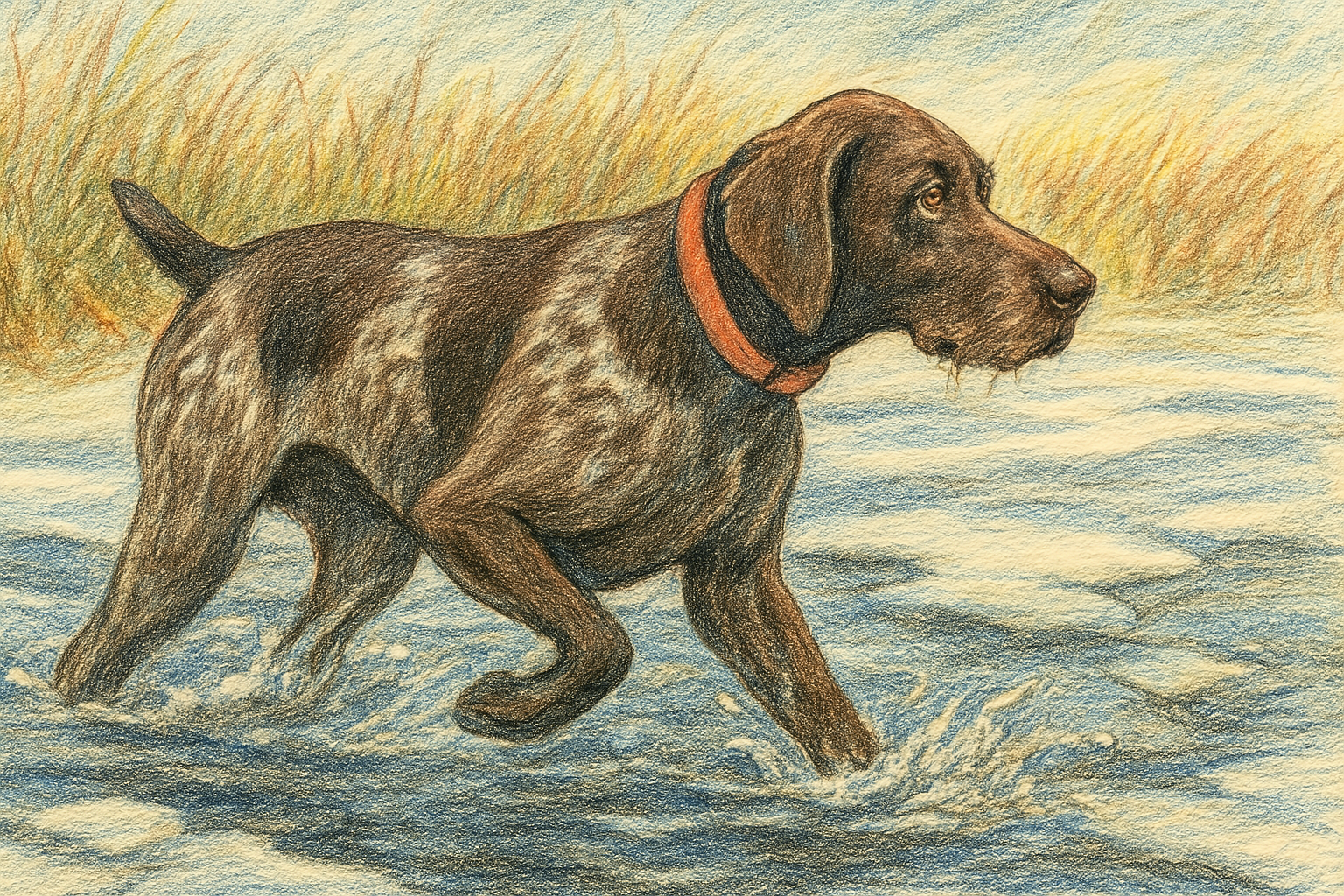In our first post of the spay/neuter series, we explored the historical context behind the veterinary profession’s recommendations for early spaying and neutering. Now, we’ll delve into recent literature to understand how spaying and neutering at various life stages compare to leaving dogs intact, focusing on five sporting breeds.
Where Did This New Information Come From?
Recent studies from the University of California, Davis, led by Drs. Benjamin and Lynette Hart, have provided new insights into the timing of spaying and neutering. Their research spans over a decade and offers specific recommendations for 40 dog breeds. While it would be nice to have these specific recommendations for all of our hunting breeds, they represented a handful of the breeds they looked at.
Guidelines and Considerations
It is crucial to note that these are guidelines, not rigid rules. These recommendations should be one of many factors considered when discussing the best path for your dog. Often, we seek black-and-white answers to apply universally, but the reality is more nuanced. Health factors are just one aspect of the decision-making process.
Historically, early spaying and neutering were advocated to prevent certain diseases and control the pet population. However, new research indicates that these practices might lead to significant health issues in some breeds, challenging long-standing veterinary practices. When we compare historic veterinary recommendations to these newer findings, it can be a tough pill to swallow, acknowledging that past practices may have caused health issues.
Despite this new information, some in the veterinary community are reluctant to change their recommendations. As a lifelong science enthusiast, it’s disheartening to see skepticism towards evolving scientific knowledge. Adapting to new information is not a failure; it’s a strength.
Data and Methodology
The current research is database-driven, primarily utilizing historic veterinary records from the UC-Davis Veterinary Hospital. This means the findings are based on a specific population that sought referral care, predominantly from California, which may influence the data. I don’t offer that as a negative or to call in to question this information. While this is the best information we currently have, what it means is that the information and guidelines could shift as more data becomes available.
The studies classified dogs into the following age groups for spaying/neutering:
- Less than six months
- 6-12 months
- Less than 2 years
- 2-8 years
They examined the occurrence of joint disorders (hip dysplasia, cranial cruciate ligament disease, elbow dysplasia) and cancers (lymphosarcoma, hemangiosarcoma, mast cell tumor, mammary cancer), and urinary incontinence in females.
Findings and Breed-Specific Recommendations
The hunting breeds that were looked at included cockers, springers, shorthairs, wirehairs, goldens and labs. While this is not an exhaustive list it does hit some of the most popular hunting breeds and it allows us to allow some generalizations that we can apply to other similar breeds. We will discuss recommendations for breeds not included here in a future post. Below are the results of these studies.
Cocker Spaniels
Data Analysis:
- 369 dogs.
- Joint Disorders: 1-3% in intact dogs; 11% in males neutered before six months. Spaying females was not associated with joint issues.
- Cancers: 6% in intact males, with no increase from neutering. However, 17% of females spayed between 1-2 years developed cancers, primarily mast cell tumors. Intact females had an 11% rate of mammary cancer and a 5% rate of pyometra.
Guidelines:
- If electing to neuter delay neutering males until after six months.
- Delay spaying females beyond two years to reduce cancer risk.
Comments:
- They did not differentiate American versus English and so I think it would be safe to assume that much of this sample would be the American version. That wouldn’t sway me away from these guidelines when dealing with field-bred English cockers; however, it may mean there is room for more detailed separation in future studies.
Springers
Data Analysis:
- 212 dogs.
- Joint Disorders: 5% in intact males and 8% in intact females. No increase with spaying/neutering.
- Cancers: 6% in intact dogs; mammary cancer rates were 6% in intact females and 15% in those spayed between 2-8 years. No pyometras were reported. Urinary incontinence occurred in 13% of females spayed at 6-11 months.
Guidelines:
- Neuter males based on owner’s preference or keep intact.
- Spay females no sooner than one year to mitigate urinary incontinence risk.
Comments
- It is interesting to note the lack of increase in joint disorders. Typically springers are going to run bigger than cockers. In cockers they did see joint issues in neutering males too young but not in springers. This shows the lack of universal application to some of the traditional rules we have used.
German Shorthairs and Wirehairs
Data Analysis:
- 443 dogs.
- Joint Disorders: 3% in intact dogs; 38% in females spayed before six months. A slight increase in cruciate ligament issues in males neutered before one year.
- Cancers: 6% in intact males and 1% in intact females. Males neutered before six months had an 8% increase in mast cell tumors and hemangiosarcomas. Females spayed before one year had an 11% increase in lymphosarcoma. Mammary cancer and pyometra rates were 4% in intact females.
Guidelines:
- If electing to neuter/spay do so no earlier than one year for both sexes.
Comments
- Not only did they lump drahts and wirehairs together they also lumped in shorthairs. I’ll give you German aficionados a moment to collect yourselves.
- I think it is interesting to note the incredible increase in joint issues in females spayed before six months. For so long we have harped on the importance of keeping males intact until skeletally mature and now we are seeing the same likely applies for females.
Golden Retrievers
Data Analysis:
- 1247 dogs.
- Joint Disorders: 5% in intact males, increasing to 25% if neutered before six months. Similar patterns were observed in females.
- Cancers: 15% in intact males; neutering before six months increased the rate to 19%. For females, intact had a 5% rate; spaying before six months increased it to 11%. Spaying at any age raised the cancer risk.
Guidelines:
- If neutering males delay until after one year.
- For females, consider leaving intact due to the increased cancer risk associated with spaying at all ages, or explore ovary-sparing spays.
Comments:
- Goldens show us just how nuanced this can be. I had previously poo-pooed the idea of an ovary sparing spay. If I owned a female Golden I would certainly be taking a look at that option.
Labrador Retrievers
Data Analysis:
- 1933 dogs.
- Joint Disorders: 6% in intact dogs; increased to 13% in males and 11% in females neutered/spayed before six months.
- Cancers: 8% in intact males, 6% in intact females; no significant increase with spaying/neutering. Mammary cancer rates were 1% in intact females and 2% in those spayed at 2-8 years. Pyometra rates were 2%.
Guidelines:
- Neuter males after six months.
- Spay females after one year.
Comments:
- I think this really drives home the point that this really needs to be an individualized conversation and not something as simple as the questions we see in internet chats of “when should I spay my duck dog” or “when to neuter my bird dog.” One just has to look at the striking differences between goldens and labs.
- Even though the study and guidelines indicate males had no statistical increase in joint issues when neutered after six months of age I personally will still advocate for waiting until skeletally mature.
Conclusion
These findings highlight the need for individualized spaying and neutering discussions. It really is more nuanced than we ever imagined. I think this also sheds some light on the fact that the extremes of — early spay and neuter and you can’t spay and neuter — are both not correct. As we evaluate these issues we can make sound decisions that satisfy a lot of owner wants and desires for their dog with the occasional outlier like the female goldens.
The guidelines are based on a relatively small sample size and primarily from a specific population at UC Davis. As more data becomes available, recommendations may evolve, reflecting a broader understanding and ongoing improvement in veterinary practices.
In the next part of this series, we will explore additional studies including those on longevity and behavior to further inform decisions around spaying and neutering.
References
- Hart, L. A., Hart, B. L., & Thigpen, A. P. (2023). Decision-Making on Recommended Age of Spay/Neuter for a Specific Dog. Veterinary Clinics of North America: Small Animal Practice, 53(5), 1209-1221. https://doi.org/10.1016/j.cvsm.2023.05.005
- Hart, B. L., Hart, L. A., Thigpen, A. P., & Willits, N. H. (2020). Assisting decision-making on age of neutering for 35 breeds of dogs: Associated joint disorders, cancers, and urinary incontinence. Frontiers in Veterinary Science, 7, 388. https://doi.org/10.3389/fvets.2020.00388
- Torres de la Riva, G., Hart, B. L., Farver, T. B., & Oberbauer, A. M. (2013). Neutering dogs: effects on joint disorders and cancers in Golden Retrievers. PLOS ONE, 8(2), e55937. https://doi.org/10.1371/journal.pone.0055937
- Hart, B. L., Hart, L. A., Thigpen, A. P., & Willits, N. H. (2014). Long-term health effects of neutering dogs: comparison of Labrador Retrievers with Golden Retrievers. PLOS ONE, 9(7), e102241. https://doi.org/10.1371/journal.pone.0102241
- Hart, L. A., Thigpen, A. P., Hart, B. L., Willits, N. H., Lee, M., Babchuk, M. M., Lee, J., Ho, M., Clarkson, S. T., & Chou, J. W. (2024). Assisting decision-making on age of neutering for German Short/Wirehaired Pointer, Mastiff, Newfoundland, Rhodesian Ridgeback, Siberian Husky: associated joint disorders, cancers, and urinary incontinence. Frontiers in Veterinary Science, 11, 1322276. https://doi.org/10.3389/fvets.2024.1322276



